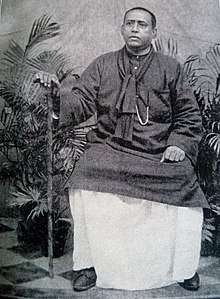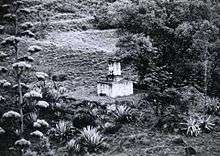Soham Swami
Soham Swami (also known as "Tiger Swami,"[1] Sohong Swami, Parmahangsa Soham Swami or Sohom Swami, Bengali: শ্রীমৎ পরমহংস সোহংস্বামী ) was a Hindu guru and yogi from India. Originally named as Shyama Kanta Bandopadhyay, he was the disciple of the Advaita Vedantist Tibbetibaba. Tibbetibaba was a great yogi and guru of India.[2]

Soham Swami | |
|---|---|
| Personal | |
| Born | Shyamakanta Bandyopadhyay 1858 |
| Died | 6 December 1918 |
| Religion | Hinduism |
| Philosophy | Advaita Vedanta |
| Religious career | |
| Guru | Tibbetibaba |
Disciples
| |
Soham Swami was born as Shyama Kanta Bandopadhyay at Adial, a small village in Bikrampur district in the Bengali month of Jaishthya in 1858[3] and was one of the pioneers of physical prowess of modern Bengal.[4][5] He had so much physical strength that he could wrestle even tigers.[6] He was known to the public, both Indian and European, as Professor Banerjee, the first tiger tamer of India, and to his admirers in Bengal as BaghaShyamakanta.[7] These tiger bouts took place before he entered into the spiritual path.[1]
Soham Swami built a hermitage near a crematorium in Bhawali in Nainital.[8] It was at the Nainital ashram, Niralamba Swami became his disciple.[9] In his early life Niralamba Swami, also known as Jatindra Nath Banerjee, was a great freedom fighter of India.[10][11]
Life


Shyama Kanta's family belonged to the Bandyoghati branch of Kulin Brahmans of Phulia Mel.[3] His father Shashibhushan Bandyopadhyay was a Sheristadar (keeper of records) in the district court in Tripura.[12] He spent his childhood in Dhaka where he studied at Dhaka Collegiate School. When he was in school, he started bodybuilding at the akhara of Adhar Ghosh at Lakshmibazar, Dhaka.[13] Later he wanted to be a soldier, but he was barred from entering into the British Indian Army.[14]
After that he was appointed the bodyguard of Maharaja Bir Chandra Manikya Bahadur of Tripura. Later he left the job and joined Barishal Zilla School as a gymnasium trainer. Soon he left that job and started a circus.[14] For 17 years Shyama Kanta entertained audience across Bengal and Bihar with his tiger wrestling acts.[15]
In 1899, he left home to become a monk. He was initiated by Nabin Chandra Chakrabarti Tibbetibaba, a Vedantic monk who renamed Shyama Kanta as ″Soham Swami″.[14]
Soham Swami set up his hermitage at Bhawali near Nainital in modern-day Uttarakhand, India. He followed the spiritual path of Advaita or non-dualism and was a staunch critic of religious bigotry and superstitions.[16] The last book written by him in Bengali, (published posthumously in 1919) Bhagabat Geetar Shamolochana, was a critical review of Bhagavad Gita.[17] On 6 December 1918, Soham Swami passed away while in deep meditation or Samadhi in his hermitage at Bhawali.[18] His samadhi(tomb) is located at Palitpur, Burdwan, India.There is also a symbolic samadhi at his Nainital ashram. It is due to the fact that after his mahasamadhi or death at his Nainital ashram, his last remains were brought to the Palitpur ashram of Tibbetibaba and a samadhi (tomb) was built at the Palitpur ashram.[19]

Written works
The writings of Soham Swami include books named:
- Soham Geeta: This book contains teachings of Soham Swami.It is a poem on Advaita philosophy.[14][20]
- Soham Tattva: This book is a collection of Bengali prose on Vedanta.[17]
- Soham Samhita: This book contains teachings of Soham Swami.[14]
- Common Sense: This book attempts to prove that all religions of the world are full of absurdities, inconsistencies, and fallacies. In this book the importance of development of common sense and realization of divinity in all beings is stressed. This book was first published in 1923.[21][22][23]
- Truth: This book was the only book written by him in English poetry. It was published in Calcutta, now Kolkata, in 1913.[14][24]
His other notable works included: Vivekgatha, Shambuka Badh Kavya, Bhagabat Geetar Shamolochana.[14][17]
Notes
- Yogananda, Sri Sri Paramahansa, Autobiography of a Yogi, Yogoda Satsang Society of India (1997) ISBN 81-7224-121-6. p.49 and 57
- Sharma, I. Mallikarjuna, "In retrospect: Sagas of heroism and sacrifice of Indian revolutionaries", Ravi Sasi Enterprises, India (edition: 1999). p. 94. Page Available
- Mukherjee, Arpita (2018). THE MONK WHO TAMED THE TIGER: Biography of Paramhangsa Soham Swami. India: Sayambhati Publication. p. 3. ISBN 9788193722909.
- Mukherjee, Jayasree, "The Ramakrishna-Vivekananda movement impact on Indian society and politics (1893–1922): with special reference to Bengal", Firma KLM. (edition 1997). ISBN 81-7102-057-7. p.255. Page available:
- Brahmachari, Akhandananda, Paramhamsa Tibbati Babar Smriti Katha(Reminiscences of Tibbetibaba),(Bengali edition), India: Tibbati Baba Vedanta Ashram, 76/3, Taantipara Lane, P.O. Santragachi, Howrah – 711 104, West Bengal (May 2003), p.28
- Murphet, Howard, Sai Baba: Man of Miracles, Weiser Boo Publication, (1977). ISBN 0-87728-335-4, p. 152. Page available
- Mukherjee, Arpita (2018). THE MONK WHO TAMED THE TIGER: Biography of Paramhangsa Soham Swami. India: Sayambhati Publication. p. 45. ISBN 9788193722909.
- Mukherjee, Arpita (2018). THE MONK WHO TAMED THE TIGER: Biography of Paramhangsa Soham Swami. India: Sayambhati Publication. p. 151. ISBN 9788193722909.
- Heehs, Peter, "The bomb in Bengal: the rise of revolutionary terrorism in India, 1900–1910", Oxford University Press. (edition 1993). p. 62. Page available:
- Jadavpur University. Dept. of International Relations Jadavpur Journal of International Relations, "Jadavpur Journal of International Relations", Dept. of International Relations, Jadavpur University, Kolkata, India. (edition: 2001). pp.117 and 122. Page Available:
- Mukherjee, Arpita (2018). THE MONK WHO TAMED THE TIGER: Biography of Paramhangsa Swami. India: Sayambhati Publication. p. 26. ISBN 9788193722909.
- Mukherjee, Arpita (2018). THE MONK WHO TAMED THE TIGER: Biography of Paramhangsa Soham Swami. India: Sayambhati Publication. p. 14. ISBN 9788193722909.
- Ghosh, Anil Chandra (2008) [1928]. ব্যায়ামে বাঙালী – Byamame Bangali [Physical Exercise and the Bengalis] (in Bengali) (9th ed.). Kolkata: Presidency Library. pp. 1–8. ISBN 81-89466-04-6.
- Mukherjee, Arpita (2018). THE MONK WHO TAMED THE TIGER: Biography of Paramhangsa Soham Swami. India: Sayambhati Publication. p. 88. ISBN 9788193722909.
- Mukherjee, Arpita (2018). THE MONK WHO TAMED THE TIGER: Biography of Paramhangsa Soham Swami. India: Sayambhati Publication. p. 195. ISBN 9788193722909.
- Mukherjee, Arpita (2018). THE MONK WHO TAMED THE TIGER: Biography of Paramhansgsa Soham Swami. India: Sayambhati Publication. p. 190. ISBN 9788193722909.
- Mukherjee, Arpita (1918). THE MONK WHO TAMED THE TIGER: Biography of Paramhangsa Soham Swami. India: Sayambhati Publication. p. 281. ISBN 9788193722909.
- Brahmachari, Akhandananda, Paramhamsa Tibbati Babar Smriti Katha(Reminiscences of Tibbetibaba),(Bengali edition), India: Tibbati Baba Vedanta Ashram, 76/3, Taantipara Lane, P.O. Santragachi, Howrah – 711 104, West Bengal (May 2003), p.48
- Ghose, Aurobindo, Karmayogin: political writings and speeches 1909–1910. Volume 8 of The Complete Works of Sri Aurobindo , Volume 8 of Works, Sri Aurobindo Ashram Publication Dept, India. (ed. 1997) p.196. Page available:
- Luzac & Co. (London, England), "Luzac's oriental list and book review", Luzac and Co.. (edition 1924). p. 33. Page available:
- Swami, Soham, "Common Sense", Bangladesh: Surja Kanta Banerjee, Gandharia Press, Dacca(Dhaka) (ed. 1923). pp. 1–3.
- University of Calcutta. Dept. of English, "Calcutta review", University of Calcutta, University of Calcutta. Dept. of English, Kolkata, India (ed. 1925). p.20. Page available:
- A Bibliography of Indian English, Central Institute of English and Foreign Languages, India. (edition 1972). p.97.

References
- Ghosh, Sudhanshu Ranjan, "Bharater Sadhak O Sadhika"(Bengali edition), India: Tuli Kalam Publication, 1, College Row, Kolkata – 700 009 (1992.Bengali calendar year – 1399), pp. 318–343
- Chakravorty, Subodh, "Bharater Sadhak – Sadhika"(Bengali edition), India: Kamini Publication, 115, Akhil Mistry Lane, Kolkata – 700 009 (1997.Bengali calendar year – 1404), Volume 1, pp. 450–478 and 500–522
- Murphet, Howard, Sai Baba: Man of Miracles, Weiser Boo Publication, (1977). ISBN 0-87728-335-4, p. 152.
- Sanyal, Jagadiswar, Guide To Indian Philosophy (1996 ed.), India: Sribhumi Publishing Company (1999), 79, Mahatma Gandhi Road, Kolkata – 700 009.
- Hornby, A S, "Oxford Advanced Learner's Dictionary of Current English" (5th ed.), UK: Oxford University Press (1998). ISBN 0-19-431445-6, pp. 1433–1475.
- Why I am an Atheist: Bhagat Singh, People's Publishing House, New Delhi, India.
- Swami, Soham, "Common Sense", Bangladesh: Surja Kanta Banerjee, Gandharia Press, Dacca(Dhaka) (1923). pp. 1–3.
- Misra, Kunjeshwar, Tibbatibabar Parichay(Bengali edition), India: Tibbati Baba Vedanta Ashram, 76/3, Taantipara Lane, P.O. Santragachi, Howrah – 711 104, West Bengal (1934. Bengali calendar year – 1341), pp. 1–60
- Brahmachari, Akhandananda, Paramhamsa Tibbati Babar Smriti Katha(Bengali edition), India: Tibbati Baba Vedanta Ashram, 76/3, Taantipara Lane, P.O. Santragachi, Howrah – 711 104, West Bengal (May 2003), pp. 1–50
- Sharma, I. Mallikarjuna, "In retrospect: Sagas of heroism and sacrifice of Indian revolutionaries", Ravi Sasi Enterprises, India (edition: 1999). p. 94.
- Roy Dilip Kumar, Devi Indira, "Pilgrims of the stars: autobiography of two yogis", India (edition: 1985). p. 357.
- Majumdar, Bimanbehari, "Militant nationalism in India and its socio-religious background, 1897–1917", General Printers & Publishers, India (edition 1966.) p. 101.
- Keshavmurti, "Sri Aurobindo, the hope of man", Dipti Publications, India. (edition 1969). p. 258.
- Heehs, Peter, "The bomb in Bengal: the rise of revolutionary terrorism in India, 1900–1910", Oxford University Press. (edition 1993). p. 62.
- "A bibliography of Indian English", Central Institute of English and Foreign Languages, India. (edition 1972). p. 97.
- Luzac & Co. (London, England), "Luzac's oriental list and book review", Luzac and Co. (edition 1924). p. 33.
- Mukherjee, Arpita, "THE MONK WHO TAMED THE TIGER: Biography of Paramhangsa Soham Swami", Sayambhati Publication, India. (edition 2018) (ISBN 9788193722909)
- Mukherjee, Jayasree, "The Ramakrishna-Vivekananda movement impact on Indian society and politics (1893–1922): with special reference to Bengal", Firma KLM. (edition 1997). ISBN 81-7102-057-7. p. 255.